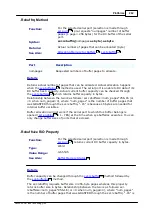
255
TIDE and Tibbo BASIC User Manual
©2000-2008 Tibbo Technology Inc.
.Interface Property
Function:
Chooses full-duplex or half-duplex operating mode for
currently selected serial port (selection is made through
).
Type:
Enum (pl_ser_interface, byte)
Value Range:
0- PL_SER_SI_FULLDUPLEX (default): full-duplex mode.
1- PL_SER_SI_HALFDUPLEX: half-duplex mode.
See Also:
,
Details
Full-duplex mode is suitable for RS232, RS422, or four-wire RS485
communications. RTS output (together with CTS input) can be used for optional
hardware flow control (
).
Half-duplex mode is suitable for two-wire RS485 communications. RTS line is used
for direction control. Hardware flow control is not possible, so ser.flowcontrol value
is irrelevant. Direction control polarity can be set through
.
This property is only relevant when the port is in the UART mode (
= 0-
PL_SER_MODE_UART).
Depending on your platform, you may be allowed to remap RTS and CTS lines to
other I/O pins of the device through the
and
properties. Also, you may be required to correctly configure RTS and CTS lines as
an input and output through the
object. See
"Platform-dependent Programming Information" topic inside your platform
specifications section.
.Mode Property
Function:
Sets operating mode for the currently selected serial port
(selection is made through
).
Type:
Enum (pl_ser_mode, byte)
Value Range:
0- PL_SER_MODE_UART (default): UART mode.
1- PL_SER_MODE_WIEGAND: Wiegand mode.
2- PL_SER_MODE_CLOCKDATA: clock/data (magstripe
interface) mode.
See Also:
Three Modes of the Serial Port
,
Details
Follows is a short introduction of three operating modes of the serial port:
UART mode
Suitable for RS232, RS422, RS485, etc. communications in
full-duplex or half-duplex mode (see
). Data is
257
226
236
253
250
255
261
249
370
365
257
225
236
255
















































